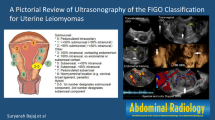Opinion statement
Esophageal leiomyomas are often discovered incidentally when a barium swallow or endoscopic examination performed for unrelated reasons reveals a smooth, submucosal mass in the esophagus. Although surgical removal and histologic examination are required to prove the diagnosis, a diagnosis of esophageal leiomyoma can be established with reasonable certainty by a careful clinical evaluation that includes endoscopy, endoscopic ultrasonography (EUS), and CT scan. If these tests reveal any feature that suggests malignancy, or if the tumor is causing symptoms, the lesion should be removed surgically, provided there is no severe co-morbidity or evidence of metastatic disease. If the imaging studies are typical of benign leiomyoma and the patient has no symptoms, therapy should be individualized. The limited data available on the natural history of esophageal leiomyomas suggests that the tumors grow slowly and that malignant transformation is extremely uncommon.
Similar content being viewed by others
References and Recommended Reading
Seremetis MG, Lyons WS, De Guzman VC, Peabody JWJr: Leiomyomata of the esophagus: an analysis of 838 cases. Cancer 1976, 38:2166–2177. An excellent review of the clinical and histologic features of esophageal leiomyoma.
Takubo K, Nakagawa H, Tsuchiya S, et al.: Seedling leiomyoma of the esophagus and esophagogastric junction zone. Hum Pathol 1981, 12:1006–1010.
Levine MS, Buck JL, Pantongrag-Brown L, et al.: Esophageal leiomyomatosis. Radiology 1996, 199:533–536.
Massari M, Lattuada E, Zappa MA, et al.: Evaluation of leiomyoma of the esophagus with endoscopic ultrasonography. Hepatogastroenterology 1997, 44:727–731. This article summarizes the endosonographic features of esophageal leiomyoma, and describes how endosonography is used to formulate management decisions for patients with submucosal esophageal tumors.
Rendina EA, Venuta F, Pescarmona EO, et al.: Leiomyoma of the esophagus. Scand J Thorac Cardiovasc Surg 1990, 24:79–82.
Evans HL: Smooth muscle tumors of the gastrointestinal tract: a study of 56 cases followed for a minimum of 10 years. Cancer 1985, 56:2242–2250.
Bonavina L, Segalin A, Rosati R, et al.: Surgical therapy of esophageal leiomyoma. J Am Coll Surg 1995, 181:257–262.
Geller A, Wang KK, DiMagno EP: Diagnosis of foregut duplication cysts by endoscopic ultrasonography. Gastroenterology 1995, 109:838–842. This article summarizes how endosonography can be used to distinguish cystic from solid submucosal lesions of the esophagus.
Rafal RB, Markisz JA: Magnetic resonance imaging of an esophageal duplication cyst. Am J Gastroenterol 1991, 86:1809–1811.
Massari M, De Simone M, Cioffi U, et al.: Endoscopic ultrasonography in the evaluation of leiomyoma and extramucosal cysts of the esophagus. Hepatogastroenterology 1998, 45:938–943.
Rösch T, Lorenz R, Dancygier H, et al.: Endosonographic diagnosis of submucosal upper gastrointestinal tract tumors. Scand J Gastroenterol 1992, 27:1–8.
Glanz I, Grunebaum M: The radiological approach to leiomyoma of the oesophagus with a long-term follow-up. Clin Radiol 1977, 28:197–200. One of very few articles that deal with the natural history of esophageal leiomyomas. This report suggests that these tumors grow very slowly and that malignant transformation is rare.
Basic Pathology, 6th edn. Edited by Kumar V, Cotran RS, Robbins SL. Philadelphia: W.B. Saunders Co.; 1997:611.
Shamji F, Todd TRJ: Benign Tumors. In Esophageal Surgery. Edited by Pearson FG, Deslauriers J, Ginsberg RJ, et al. New York: Churchill Livingstone. 1995; 519–538.
Roviaro GC, Maciocco M, Varoli F, et al.: Videothoracoscopic treatment of oesophageal leiomyoma. Thorax 1998, 53:190–192.
Kajiyama T, Sakai M, Torii A, et al.: Endoscopic aspiration lumpectomy of esophageal leiomyomas derived from the muscularis mucosae. Am J Gastroenterol 1995, 90:417–422.
Hyun JH, Jeen YT, Chun HJ, et al.: Endoscopic resection of submucosal tumor of the esophagus: results in 62 patients. Endoscopy 1997, 29:165–170. This report summarizes the results of endoscopic resection for esophageal leiomyomas.
Author information
Authors and Affiliations
Rights and permissions
About this article
Cite this article
Spechler, S.J., Waxman, I. Esophageal leiomyomas. Curr Treat Options Gastro 3, 71–76 (2000). https://doi.org/10.1007/s11938-000-0063-2
Issue Date:
DOI: https://doi.org/10.1007/s11938-000-0063-2




